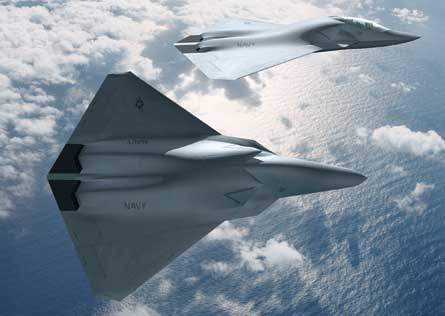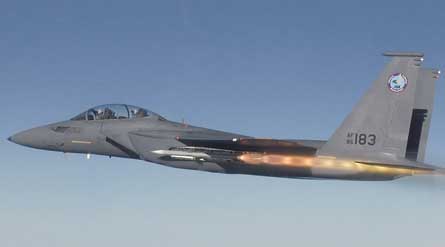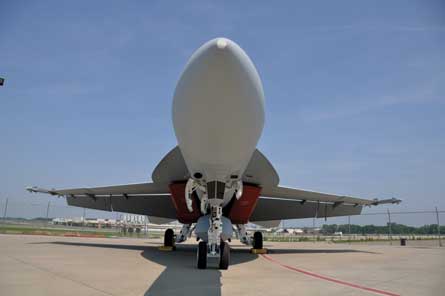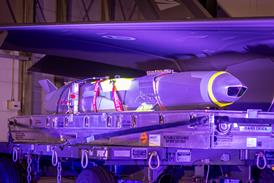Stephen Trimble/Pairs and St Louis
Nearly 10 years ago it strongly appeared that Boeing might be a spent force in the manned fighter aircraft business. Lockheed Martin's victory in the competition for the Joint Strike Fighter (JSF) contract - announced on 26 October 2001 - sounded the warning.
The only new tactical fighter planned during the next 25 years or so would roll off Lockheed's assembly line in Fort Worth - not Boeing's fighter factory in St Louis. The F-35 was first scheduled to enter service in 2008. By then, orders for the F/A-18E/F Super Hornet and F-15E Strike Eagle would finally dry up with nothing to replace them.
As the 10th anniversary of the JSF contract award looms, the history of the past decade tells a much different story.
 |
|---|
© Boeing |
The US Navy ADF, previously known as the F/A-XX and NGAD |
The company that acquired tactical aircraft specialist McDonnell Douglas in 1997 is still very firmly in the manned fighter business. Orders for both the Super Hornet and Strike Eagle are backlogged through the middle of the decade. How long Boeing can stretch out production of those legacy types remains to be seen, but company leaders think demand for the Super Hornet could extend into the early 2020s.
INTERNAL CHANGES
But perhaps more surprising is what may follow. Boeing is in the early stages of preparing to compete for the next manned fighter programme. The preparations reveal the extent of internal changes within its military aircraft division during the past three years to transform how a defence company operates in a new era of tight budgets and risk-averse customers.
"It's a mindset change," says Chris Chadwick, president of Boeing Military Aircraft. "Yes, it's about doing things better and smarter. But really it's about cost; it's a variable that's just as important as capability and schedule. We're not there yet, but I think that, fundamentally, we can make that strategic shift. And that could become a competitive advantage for us."
The current environment does not lend itself to optimism about the chances for launching yet another tactical aircraft programme.
Indeed, in February, Michael Donley, Secretary of the Air Force, told reporters that a sixth-generation fighter will not be launched "anytime soon".
"We do continue the R&D [research and development] in Air Force Research Laboratory and other dimensions of our ongoing R&D work relative to advanced components, avionics, weapons that will eventually support that work," Donley said. "So the early pieces of what would constitute a future programme are already out there."
Three months before Donley's comments to reporters, the air force asked the defence industry to submit ideas for a next-generation tactical aircraft system to enter service after 2030. The concept is now known in the air force as the F-X, according to Boeing.
Meanwhile, a similar project in the navy has also changed names since the concept was revealed in June 2008. The US Navy started by calling it the F/A-XX, then switched to "next-generation air dominance" (NGAD) fighter, and now it is simply the air-dominance fighter (ADF).
Whereas the F-35 is aimed at replacing four aircraft types - A-10, AV-8B, F-16C/D and F/A-18A-D - the ADF and F-X would be launched to replace only two: the navy's F/A-18E/F and the air force's F-22.
Neither programme is the most immediate acquisition priority for either service. The air force is committed to fielding a replacement for the B-52 by the end of the decade. Meanwhile, the navy intends to buy an unmanned, carrier-launched surveillance and strike (UCLASS) aircraft.
Beyond those requirements lies the opportunity that Boeing is preparing for. Only a year ago, Boeing managers unveiled two strike-fighter concepts.
Chadwick admits pragmatically that he doubts some of his own forecasters.
"My folks are probably more optimistic than I am about when that's going to happen," Chadwick said.
SEPARATE ANALYSES
But it is known that the air force and navy are both conducting separate analyses to define the scope of the requirements and the most feasible alternatives for the ADF and F-X.
The studies have caught the attention of the office of the Secretary of Defense. The office's most recent 30-year forecast of military aircraft requirements indicates that manned and unmanned options for the navy's ADF programme. New aircraft models will be traded against the option of converting the navy's F-35C from a strike fighter into an air-dominance fighter, according to the forecast. For Boeing it is a familiar scenario. The same F-35 that appeared to end the airframer's fighter business 10 years ago may yet capture the St Louis line's best hope for long-term survival.
Boeing also faces the reality of the company's recent track record. For the past 30 years, its military aircraft division has depended on selling derivatives of military or commercial aircraft, such as the P-8A Poseidon, KC-46A tanker and the F/A-18E/F Super Hornet.
But it has been more than three decades since Boeing or one of its legacy companies has been mainly responsible for successfully moving a developmental aircraft design into full-scale production. The exception is the V-22 Osprey, produced in partnership with Bell Helicopter. On the other hand, two other partnerships failed during the same period, wasting billions of dollars in development funding on the McDonnell Douglas/General Dynamics A-12 Avenger and the Sikorsky/Boeing RAH-66 Comanche.
The Department of Defense's tolerance for investing in risky development projects is dropping. The next-generation bomber may field a new airframe, but other key technologies, such as propulsions, avionics and weapons, should be based on existing technologies.
NEXT-GENERATION FIGHTER
As Boeing looks to compete for a next-generation fighter, company officials are careful to emphasize the lessons it has learned. Indeed, Boeing's defence leadership has raised its rhetoric to a new level, unveiling a new model in the company for conceiving and executing clean-sheet aircraft.
The DoD's acquisition system has many faults, and few are more obvious than its approach to fielding new combat aircraft. Spiralling acquisition costs that either terminate or significantly curtail planned weapons procurements are not a recent phenomenon.
In 1984, Norm Augustine, then chief executive officer of Martin Marrietta, plotted the upward trajectory of cost trends for military aircraft. In Augustine's model, the cost of a single fighter aircraft rose over 70 years to consume the entire US defence budget in 2054. The prediction is known as Augustine's Law Number 16.
"As a business and as an industry we need to break Augustine's Law," Chadwick said. "We've got to figure out how to design in the right capability at the right cost and not to try to cave it out at the end of the cycle."
COST OVERRUNS
To "cave it out" is an expression that means to pay for cost overruns by reducing the number of aircraft delivered at the end of the production cycle. As fewer aircraft are delivered, unit costs increase even further, which often prompts more cuts to production. This scenario was labelled "the acquisition death spiral" by Chuck Spinney, a former DoD analyst.
To address these issues, the DoD has launched several acquisition-reform initiatives in the past several years, says Dan Seal, a Boeing programme manager.
"The DoD 5,000.2, the Weapon Systems Acquisition Reform Act, the new [director of defence research and engineering] Systems 2020 initiative that was recently launched late last year - all those are aimed at kind of fixing that acquisition cycle," Seal says.
Industry cannot control the internal processes used by the DoD weapons buyers to control requirements and budgets. But the aircraft companies do have the power to control the key element of airframe and systems design at the outset.
Boeing's focus is on making sure the design looks beyond the operational requirements and considers the impact of maintenance costs.
"You will lock in 70-80% of the aircraft's life-cycle cost early in that conceptual design phase. You won't realise the cost until later, but the design decisions you make early on will lock in that acquisition cost. So you really want an environment where you can identify, find and fix problems early when they're less costly to change than later on when you're into production," Seal says.
This new approach has changed the way Chadwick's division manages all aircraft programmes throughout the company. Under a concept called 21st Century Prime Contractor, Boeing's leaders have accepted a new role. It will no longer be enough for a prime contractor to integrate complex systems to meet a set of increasingly sophisticated operational requirements. The prime contractors also have to create savings within programmes by using their clout to reduce prices in the supply chain.
"The business model has changed around us. The primes have to be able to show their ultimate value to the customer as we head into the 21st century," Chadwick says.
"So we're very much looking at our design approach where the control points are between us and our suppliers and the ultimate future would be where we have a design and you have continuous competition with your supply chain for different elements of a platform or a capability.
"Ultimately that's what the customer wants," he adds. "They talk about a commercial approach but what they really want is an affordable approach, and the best way to get to affordability is to have competition within the supply chain, much like Apple does today."
Consumer electronics maker Apple is perhaps a surprise inspiration for a military aircraft manufacturer under Boeing's new model. As Chadwick describes it, Apple is adept at creating innovative new products. The model is based on Apple identifying "a nucleus of capability" that is reserved as intellectual property. Then, an extended supply chain competes ferociously to develop applications for Apple's devices.
SEAMLESS INCORPORATION
"Once you get that right you just iterate it until you get the cost out. But the value of this business model is as new technology comes along you can more seamlessly incorporate it into that platform," Chadwick says. "So at the end of the day I don't know if you can continue to compete at 100% or at 60%, but it's a better value proposition for the customer in the future."
 |
|---|
© Boeing |
Orders for Boeing F-15E Strike Eagle are backlogged through the middle of the decade |
This part of Boeing's strategy has already taken shape within the military aircraft division. In a major shake-up, last October, Chadwick realigned the unit's major segments into topical areas. The rotorcraft division was split up, with the CH-47 programme moving to the same division as the C-17 and the AH-64 joining the F-15 and F/A-18E/F programmes. Meanwhile, supplier management was elevated to Chadwick's level.
"Now, suddenly you can manage the supply chain in a positive way across a portfolio of products rather than just a product," Chadwick said. "That brings with it inherent competitiveness. It brings with it economy of scale, and I can leverage capability and products across all my platforms to lower cost and drive competition back to the supply chain."
How this strategy survives the cumbersome DoD acquisition strategy is going to be the biggest challenge. Even if Boeing can, for example, offer to leverage the navy's investments in new technologies for the F/A-18 to discount similar upgrades for the F-15, nothing in the acquisition system forces the air force to accept navy-funded upgrades. There is also the question of political influence, which tends to be based on standalone platforms at the expense of portfolio-wide savings opportunities.
Chadwick agrees the acquisition process is complex, but insists the new model works because Boeing has already seen the benefits applied to existing programmes. Despite being pressed to describe such savings in detail, Chadwick was reluctant to offer specific examples because of competitive sensitivities.
"If I can offer an opportunity to provide, say, display technology across several platforms or processing capability across several programmes, [the military customers and Boeing's suppliers] love that because that because you can spread the development cost, and from a supplier perspective they're able to put more product out the door," Chadwick said.
Another key change within Boeing was the launch of the immersive collobaorative environment programme in 2009. "When we prototyped this last year we actually saw a 60% reduction in the conceptual design cycle time, so that's huge. But we also saw much, much better quality designs coming out of that by engaging all of these stakeholders on in the early design process," Seal says.
Boeing's immersive prototyping approach takes old tools, such as computer-aided design models and adds a three-dimensional component. Existing CAD models require designers to imagine their products in three-dimensional space. That usually works for engineers working intensely on the same project every day, but it is not as helpful to the many other departments and suppliers that have a stake in the engineering or financial outcome of the engineer's decisions.
"As a non-designer we found it's really helpful to see in 3-D what this thing looks like; with just a short exposure to it you get what it looks like," Seal says.
Boeing's prototyping environment also can be used for engineering analysis. "If you have a wing design you want to do aerodynamic analysis, especially when you want to deploy slats - what would that look like? Once again, it's a full 3-D model, you can interrogate it, you can deploy flats or slats, depending on what it has," Seal said. "And then you can actually turn on the aerodynamic-analysis data on top of this model. It's a dynamic CAD model so you can see the airflow over it. You can actually zoom it. You can actually be sitting on top of the wing looking at the air coming at you."
PROBLEM AREA
"So once again it's very immersive," Seal adds. "You can do all the section cuts you want and looking at finite element data or computational fluid dynamics or thermal analysis or acoustic or aero and typically you'll take section cuts until you discover where the problem area is and focus on that. Well, we found when you combine the analysis data and the CAD data your eyes immediately gravitate to where the problem area is because it's obvious and then you can immerse yourself and you can immerse all the appropriate stakeholders very quickly to decide what you're going to do about that."
 |
|---|
© Boeing |
Boeing leaders believe that demand for the Super Hornet could stretch into the early years of next decade |
In addition, Boeing is using the collaborative tool to plan the factory flow before the contract is even awarded. The mathematical model can show the entire assembly team the best way to assemble the aircraft in sequence, and all of the tooling required to complete the job.
"If I were to modify the aircraft I can export the file right into here and say: 'Ooh, it doesn't fit in that jig anymore.' So what seemed a very innocuous design change could actually have a huge ripple impact because I've got to re-tool from an existing jig or fixture," Seal says.
"So here's an example. We have the main keels laid in. Next, we can add some additional aircraft structural components and subsystem components as well. We also have the ability to integrate human ergonomic models. You can actually look at what it takes from a manufacturing person to actually assemble this. Finally, we can come over here and show as you were putting the upper and lower skins on and the landing gear as well what it might look like.
"Now, this isn't a substitute for the high-fidelity downstream simulations you're going to need, like the flight simulation work where you've got an operator in the loop in the real cockpit, flying real flight control modes," Seal says.
"That will come downstream, but early on we found that this was very useful."
The US Navy ADF, previously known as the F/A-XX and NGAD
Orders for Boeing's F-15E Strike Eagle are backlogged through the middle of the decade
For a video preview of Boeing's next-generation fighter design, visit flightglobal.com/stlouisclips
Boeing leaders believe that demand for the Super Hornet could stretch into the early years of next decade
Source: Flight International


























